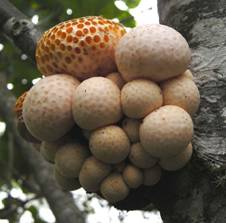|
|
|
 Phaffia
rhodozyma is a basidiomycetous pink yeast that until recently was found exclusively in slime fluxes of certain broad-leafed trees in
the northern hemisphere. The slime fluxes are rich in sugars and other
carbohydrates and P. rhodozyma takes advantage of its
fermentative abilities to use these substrates. Phaffia
rhodozyma is a basidiomycetous pink yeast that until recently was found exclusively in slime fluxes of certain broad-leafed trees in
the northern hemisphere. The slime fluxes are rich in sugars and other
carbohydrates and P. rhodozyma takes advantage of its
fermentative abilities to use these substrates.
|
 Slender,
non-septate basidium of Xanthophylomyces dendrorhous, the sexual
state of Phaffia rhodozyma with two basidiospores. The basidium is
formed directly from a yeast cell after conjugation with its bud and hyphae
are not formed. © D. Libkind 2008
|
|
 One of the most remarkable features of P. rhodozyma is
the pink to orange color of its colonies due the production of carotenoid
pigments. The main carotenoid pigment produced by P. rhodozyma is astaxanthin, a compound not formed by any other yeast species.
Astaxanthin is economically important because it is an aquaculture feed
component needed for pigmentation of fish and crustaceans and is the most
expensive feed ingredient in the aquaculture industry. One of the most remarkable features of P. rhodozyma is
the pink to orange color of its colonies due the production of carotenoid
pigments. The main carotenoid pigment produced by P. rhodozyma is astaxanthin, a compound not formed by any other yeast species.
Astaxanthin is economically important because it is an aquaculture feed
component needed for pigmentation of fish and crustaceans and is the most
expensive feed ingredient in the aquaculture industry.
Phaffia
astaxanthin is commercially available as a natural source of the carotenoid
astaxanthin.

 Very recent work carried
out by Diego Libkind in Patagonia (Argentina) has lead to the isolation, for
the first time, of P. rhodozyma
in the southern hemisphere. Very recent work carried
out by Diego Libkind in Patagonia (Argentina) has lead to the isolation, for
the first time, of P. rhodozyma
in the southern hemisphere.
|

Diego Libkind –
Colleague and friend from Universidad Nacional del Comahue, Centro Regional
Universitario Bariloche, Argentina.
 The
same work has lead to the detection of a new habitat for P.
rhodozyma: the sugar-rich fruiting bodies of Cyttaria hariotii, a fungal parasite of trees of the genus Nothofagus. The
same work has lead to the detection of a new habitat for P.
rhodozyma: the sugar-rich fruiting bodies of Cyttaria hariotii, a fungal parasite of trees of the genus Nothofagus.
|
|
 Cyttaria stromata growing on a Nothofagus trunk. Image
credits: http://en.wikipedia.org/wiki/Cyttaria
|
|
|
 We
gathered preliminary evidence that different lineages of P.
rhodozyma colonize different host trees. Coherent groups based on ITS
(rDNA Internal Transcribed Spacer) sequence data were found for the strains
isolated from Betulaceae (Betula
and Alnus), Cornus, Fagus and Nothofagus /
Cyttaria. We
gathered preliminary evidence that different lineages of P.
rhodozyma colonize different host trees. Coherent groups based on ITS
(rDNA Internal Transcribed Spacer) sequence data were found for the strains
isolated from Betulaceae (Betula
and Alnus), Cornus, Fagus and Nothofagus /
Cyttaria.
|
 Phylogenetic
relationships between different isolates of Xantophyllomyces
dendrorhous (asexual state: Phaffia
rhodozyma) and their plant hosts.
|
|
|
|
 These
findings suggest that genetically different populations of P.
rhodozyma, each associated with a different plant host, colonize the
same geographical region but do not interbreed. Another interesting
observation is the congruence between the ITS phylogenetic trees of Phaffia and its plant hosts. These
findings suggest that genetically different populations of P.
rhodozyma, each associated with a different plant host, colonize the
same geographical region but do not interbreed. Another interesting
observation is the congruence between the ITS phylogenetic trees of Phaffia and its plant hosts.
|
|
 Current
studies aim at (i) testing the hypothesis that P.
rhodozyma encompasses different lineages, each associated with a
different plant or fungal host; (ii) validating the claim that the molecular
phylogeny of the different lineages of P.
rhodozyma reproduces that of its plant hosts and that basal Phaffia lineages are associated with ancestral tree hosts; (iii)
calculating the degrees of intra-lineage and inter-lineage genetic
recombination; (iv) determining if Phaffia
can be found in other regions where Nothofagus
and Cyttaria exist and if, besides
C. hariotii, other Cyttaria species harbour P.
rhodozyma. Current
studies aim at (i) testing the hypothesis that P.
rhodozyma encompasses different lineages, each associated with a
different plant or fungal host; (ii) validating the claim that the molecular
phylogeny of the different lineages of P.
rhodozyma reproduces that of its plant hosts and that basal Phaffia lineages are associated with ancestral tree hosts; (iii)
calculating the degrees of intra-lineage and inter-lineage genetic
recombination; (iv) determining if Phaffia
can be found in other regions where Nothofagus
and Cyttaria exist and if, besides
C. hariotii, other Cyttaria species harbour P.
rhodozyma.
|
|

|
|
|
|
|
|